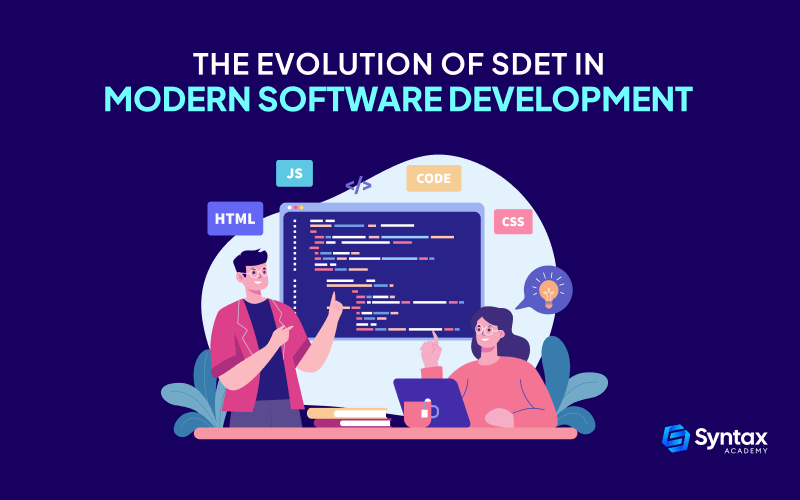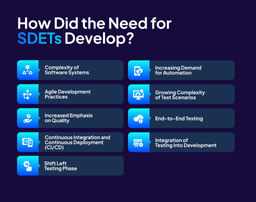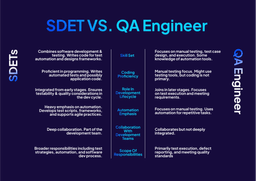In the ever-evolving world of modern software development, the role of a Software Development Engineer in Test (SDET) isn’t just a job; it’s a thrilling evolution, a tech adventure waiting to unfold!
As the global data extravaganza is gearing up to hit a whopping 180 zettabytes, accurate and lightning-fast testing is more than just a need it’s the hero we’ve been waiting for!
And guess what?
Syntax Technologies is right at the front lines, not just witnessing but leading the charge in the talent landscape of software automation and data analysis.
From the good old days of manual testing to the current era of automated precision, we invite you to buckle up and join us on a journey through the evolution of QA Automation Testing.
Imagine this journey as a map, and an QA automation testing course is your key to unlocking a treasure trove of opportunities in the vast landscape of the software development industry.
How Did the Need for SDETs Develop?
The need for QA Automation Tester evolved in response to the challenges and demands of modern software development.
Several factors contributed to the emergence of this specialized role:
Complexity of Software Systems
First up, imagine software systems turning into intricate digital mazes. Traditional manual testing? Well, it tried its best, but it couldn’t keep up with the complexity of the code. That’s where our hero, the SDET, steps in to ensure comprehensive test coverage and spot those elusive defects!
Agile Development Practices
Then came the era of agile development fast, furious, and oh-so-iterative! Traditional testing methods? They were doing the cha-cha while Agile was breakdancing. SDETs, our dance-floor stars, brought in automation to keep up with the rapid release cycles, making software testing more efficient and smooth.
Increased Emphasis on Quality
Quality became the buzzword, and software applications were the VIPs of various industries. SDETs, like quality guardians, stepped in early to prevent defects, ensuring organizations stayed ahead in the speed-to-market game.
Continuous Integration and Continuous Deployment (CI/CD)
Next up is the rise of CI/CD practices. Traditional manual testing? It was like bringing a tricycle to a Formula 1 race. SDETs became the racers, embracing automated testing to support continuous integration and deployment in these fast-paced development rollercoasters.
Shift Left Testing Phase
“Shift left” became the cool kid in testing, advocating for early testing in the software development process. SDETs, the pioneers of early detection, integrated testing into the development workflow, catching and fixing issues like superheroes in action!
Increasing Demand for Automation
Automation wasn’t just a trend; it became a necessity. SDETs, the magicians of code, answered the call for rapid, repeatable, and reliable testing, especially in the intricate world of regression testing.
Growing Complexity of Test Scenarios
As the testing scenarios got more complex than a Rubik’s Cube, SDETs embraced the challenge. Diverse platforms, browsers, and devices? No problem! SDETs specialized in creating automated tests that could handle it all a true feat of digital acrobatics!
End-to-End Testing
End-to-end testing became the anthem, ensuring software systems harmonized seamlessly across various components. SDETs, the conductors of the testing orchestra, designed and implemented end-to-end testing strategies like musical maestros.
Integration of Testing into Development
And finally, SDETs played matchmaker, uniting developers and testers in a collaboration dance. Integrating testing into the development process, they became the troubleshooters, identifying and resolving issues early in the development love story.
The Role of SDET in the Software Development Process
Let’s dive into the incredible world of Software Development Engineers in Test (SDETs), where the magic happens at the intersection of software development and quality assurance.
Here are critical aspects of the QA Automation Tester’s role in software development:
Automated Testing
- SDETs design, develop and maintain automated test frameworks and scripts to validate software applications’ functionality, performance, and security.
- Automation is crucial for repetitive and time-consuming testing tasks, enabling faster feedback loops and efficient identification of defects.
Code Quality Assurance
- SDETs contribute to code quality by conducting code reviews, ensuring that developers adhere to coding standards, and promoting best practices in software development.
- They actively participate in the development process, advocating for codebase testability, scalability, and maintainability.
Collaboration with Development Teams
- SDETs work closely with software developers, fostering a collaborative environment where testing is integrated seamlessly into the development lifecycle.
- Collaboration ensures that testing is not a separate phase but an integral part of the development process, promoting early defect detection.
Continuous Integration and Deployment (CI/CD)
- SDETs contribute to CI/CD pipelines, enabling the continuous integration, testing, and deployment of code changes.
- Automating these software development processes enhances software delivery speed while maintaining high quality through automated testing.
Performance and Scalability Testing
SDETs assess the performance and scalability of applications, identifying and addressing potential bottlenecks or issues related to the system’s ability to handle increasing loads.
Security Testing
SDETs integrate security testing into the development process, ensuring that applications are resilient against potential security vulnerabilities and threats.
Bug Advocacy
SDETs identify and prioritize bugs, collaborating with developers to resolve them in a timely manner.
Test Planning and Strategy
SDETs contribute to test planning and strategy, determining the scope and approach of testing efforts based on project requirements and goals.
Adopting New Technologies
SDETs keep up with new tech and trends in software development and testing, using new tools to improve the testing process.
The SDET role bridges the gap between development and testing, promoting a collaborative and efficient approach to software quality assurance.
This integration of testing into the development process is crucial for delivering high-quality software in a rapidly evolving technological landscape.
The Differences Between an SDET and a QA Engineer
You might wonder if an SDET role is more suitable for you than a QA engineer position.
So, what exactly are the main differences between the two?
While both share the common goal of ensuring software quality, there are distinct differences between a QA Automation Tester and a QA Engineer.
Here are the key differentiators:
Skill Set:
- SDET: Possesses a hybrid skill set that combines software development and testing expertise. SDETs can write code for test automation, design test frameworks, and contribute to the development process.
- QA Engineer: Primarily focuses on manual testing, test case design, and execution. While they may have some knowledge of automation tools, their primary role is often centered around manual testing activities.
Coding Proficiency:
- SDET: Proficient in programming languages and actively involved in writing code for automated tests. They may also contribute to the development of the application code, making them an integral part of the development team.
- QA Engineer: Relies on manual testing techniques and may use testing tools for executing test cases. Coding skills are not typically a primary requirement, and their involvement in the development process is more limited.
Role in Development Lifecycle:
- SDET: Integrates testing into the development process from the early stages. Works closely with developers, participates in code reviews, and ensures that testability and quality considerations are addressed throughout the development lifecycle.
- QA Engineer: Often involved in testing activities during later stages of the development lifecycle. Their primary focus is executing test cases, reporting defects, and ensuring the final product meets specified requirements.
Automation Emphasis:
- SDET: Places a strong emphasis on test automation. Designs and develops automated test scripts, frameworks, and tools to increase testing efficiency, enable continuous integration, and support agile development practices.
- QA Engineer: While they may use automated testing tools, their primary focus is on manual testing. Automation, if used, is typically for repetitive and time-consuming tasks rather than comprehensive test automation.
Collaboration with Development Teams:
- SDET: Works closely with developers as part of the development team. Collaborates on designing and implementing features with an understanding of testing implications.
- QA Engineer: Collaborates with development teams but may not be as deeply integrated into the development process. Often provides feedback on the application from a testing perspective.
Scope of Responsibilities:
- SDET: Has a broader scope of responsibilities, including designing and implementing test strategies, developing automated tests, and contributing to the overall software development process.
- QA Engineer: Primarily responsible for executing test cases, finding and reporting defects, and ensuring the software meets quality standards.
?
In summary, while both SDETs and QA Engineers contribute to software quality, SDETs have a more comprehensive role that extends into the realms of software development and automation, whereas QA Engineers typically focus on manual testing activities.
The distinction in skill sets and responsibilities reflects the evolving needs of the software industry in adopting agile and automated testing practices.
Plus, keep in mind that being a QA won’t stop you from getting a job as an SDET if you know the exact prerequisites for moving to a QA Automation tester position.
Application of SDETs in Multiple Career Fields (with examples)
SDETs arent just about tradition, but they bring valuable software development skills to a wide range of career fields. Their expertise in both coding and testing can be applied in diverse domains.
Here are examples of how SDETs can contribute to different industries:
Finance and Banking:
Application: SDETs can work on testing financial software, ensuring the accuracy of calculations, compliance with regulatory requirements, and the security of transactions.
Healthcare:
Application: SDETs can play a key role in developing and testing healthcare applications. They can ensure the software used in patient care, data management, and electronic health records is reliable, secure, and compliant.
E-commerce:
Application: SDETs are crucial in testing e-commerce platforms, focusing on functionalities like payment processing, inventory management, order fulfillment, and ensuring a seamless user experience.
Automotive Industry:
Application: SDETs can be involved in testing software for in-vehicle systems, ensuring the reliability of features like navigation, infotainment, and safety systems.
Telecommunications:
Application: SDETs contribute to testing telecommunications software, including mobile applications, network infrastructure, and communication protocols, to ensure optimal performance and reliability.
Gaming Industry:
Application: SDETs can work on testing video games, ensuring that software functionalities, graphics, and user interactions meet quality standards.
Aerospace and Defense:
Application: SDETs can be involved in testing software used in aerospace and defense applications, such as flight control systems, simulation software, and communication systems.
Retail:
Application: SDETs can contribute to testing retail software, including point-of-sale systems, inventory management, and customer relationship management (CRM) systems.
?Energy Sector:
Application: SDETs can apply their skills in testing software used in energy management, smart grids, and monitoring systems to ensure the reliability and efficiency of energy-related applications.
Education Technology (EdTech):
Application: SDETs can work on testing educational software and platforms, ensuring the functionality of e-learning tools, assessment systems, and student management platforms.
Supply Chain and Logistics:
Application: SDETs can contribute to testing software used in supply chain management, logistics, and warehouse management systems, ensuring the smooth flow of goods and information.
Insurance:
Application: SDETs can be involved in testing insurance-related software, including policy management systems, claims processing, and risk assessment tools.
Real Estate:
Application: SDETs can contribute to testing real estate software, including property management systems, online platforms for property transactions, and customer relationship management for real estate professionals.
Travel and Hospitality:
Application: SDETs can work on testing software in the travel and hospitality industry, ensuring the functionality and reliability of booking platforms, reservation systems, and travel management tools.
The versatility of QA Automation Tester skills makes them valuable contributors to diverse industries, ensuring the quality and reliability of software applications in various domains.
How to Get Started as a Beginner in SDET
Starting an SDET career as a beginner involves several steps in the software development process that combine learning essential skills, gaining practical experience, and building a strong foundation in software development and testing.
Here’s a guide to help you get started:
Understand the Role of an SDET
Research and understand the responsibilities and expectations of an SDET. Recognize the role’s significance in bridging the gap between software development and testing.
Basic Programming Knowledge
Begin by learning a programming language commonly used in test automation, such as Python, Java, or JavaScript.
Learn Version Control
Familiarize yourself with version control systems, particularly Git. Platforms like GitHub provide an environment to practice version control in real-world scenarios.
Basic Understanding of Software Development
Gain a basic understanding of software development principles. This includes how data is structured, how applications are built, and the software development lifecycle.
Introduction to Testing
Learn fundamental testing concepts, including types of testing (e.g., unit testing, integration testing) and testing methodologies (e.g., Agile, Scrum).
Explore Test Automation Basics
Explore online tutorials for introductory courses on test automation tools like Selenium or Appium. Understand the basics of creating automated tests and test scripts.
Practice Coding and Problem Solving
Engage in coding challenges that will help improve your problem-solving skills and coding proficiency.
Build a Simple Automation Project
Apply your learning by building a simple automation project. It could be a script to interact with a website or automate a repetitive task. This way, you can build a more robust resume by mentioning personal projects that catch the attention of software engineer recruiters.
Understand Continuous Integration/Continuous Deployment (CI/CD)
Learn about CI/CD practices and how they fit into the software development lifecycle. Familiarize yourself with tools like Jenkins or Travis CI.
Networking and Community Engagement
Join online forums, communities, or social media groups related to software testing and automation. Engaging with the community can provide insights, support, and opportunities for learning.
Explore Testing Frameworks
Learn about testing frameworks (e.g., JUnit, TestNG for Java, pytest for Python). Understand how frameworks help organize and execute tests effectively.
Specialize in an Area
Consider specializing in a specific area, such as mobile app testing, API testing, or performance testing. Specialization can make you more marketable.
Continuous Learning
Stay updated with industry trends and advancements. Follow blogs, read books, and explore advanced topics as your skills progress.
Online Courses and Certifications
Consider taking online QA Automation Testing courses or certifications offered by reputable platforms. Certifications can enhance your credibility as a testing professional.
Apply for Internships or Entry-Level Positions
Look for internships or entry-level positions in software testing or quality assurance. Practical experience is invaluable for learning and refining your skills.
Build a Strong Portfolio
Document your projects, learning experiences, and achievements in a portfolio. A well-crafted portfolio showcases your capabilities to potential employers.
Attend Webinars and Workshops
Participate in webinars and workshops, especially those focused on emerging trends and technologies in software testing. Syntax Technologies, for example, offers valuable insights through online events.
Seek Mentorship
Connect with experienced professionals in the field and seek mentorship. Guidance from those with industry experience can provide valuable perspectives and advice.
Job Search and Interviews
Tailor your resume to highlight your relevant skills and experiences. Practice common interview questions and be prepared to discuss your projects and problem-solving approaches.
Remember, becoming proficient as an SDET is a journey that involves continuous learning and practical application of skills.
Stay curious, seek opportunities to challenge yourself, and embrace the iterative nature of software development and testing.
Starting Your Journey in SDET and Paving Your Way to a Brighter Future
As we wrap up this guide, let’s put on our explorer hats and recognize that the journey to becoming a Software Development Engineer in Test is not just a pathit’s a dynamic and seriously rewarding adventure.
But here’s the inside scoop: mastery in this realm is all about commitment. Commitment to continuous learning, getting your hands dirty with hands-on experience, and nurturing that burning passion for the ever-evolving dance between software development and testing.
So, don’t just walk, strut! And in this digital jungle, there’s a treasure trove of wisdom waiting for you. Engage with communities, hop into webinars, and why not snag a mentor or two? It’s like adding rocket fuel to your understanding and exposing yourself to diverse perspectives within the testing realm.
So here’s to you, future SDET maestro! Keep coding, keep testing, and keep embracing the adventure. Your journey is not just about becoming an SDET; it’s about becoming a tech wizard, a problem-solving ninja, and a key player in the ever-evolving tech spectacle!



